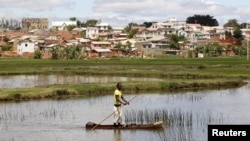Hunger is expected to reach emergency levels by the end of the year in drought-hit southern Madagascar, where many families have already been forced to sell their homes or land, or migrate, the World Food Program (WFP) has warned.
At least 1 million people need food and cash aid, and some 200,000 pregnant women and children under five need treatment for acute hunger, the U.N. agency said.
Four out of nine districts in the southern tip of the country are likely to fall to emergency hunger levels by the end of the year, according to preliminary results of a food assessment carried by out by WFP and other agencies.
The survey also showed that three more districts could follow unless swift action is taken.
The districts are currently in phase three of a five-point scale used by food agencies, where five is famine.
"The situation is extremely worrying," WFP Executive Director Ertharin Cousin said as she concluded a visit to the Indian Ocean island nation this week.
"I met women who told me they had nothing to feed their babies except the fruit of the red cactus growing by the roadside," Cousin said in a statement.
"The hunger and malnutrition we're seeing is the result of three years of ruined harvests. We must receive the necessary funding to respond before it's too late," she said.
El Nino, a warming of sea surface temperatures in the Pacific, has aggravated dry conditions and a worsening food crisis not only in Madagascar, an island 400 km (250 miles) off the coast of mainland Africa, but also across the wider southern African region.
In southern Madagascar, one household in three has already been forced into desperate measures such as selling their house or land, begging or migrating, WFP said.
Four in 10 households have eaten their vital seed stocks, leaving nothing for the November/December planting season, the agency said.
Overall, some 1.2 million people in the south are food insecure, with 600,000 severely food insecure, according to an assessment carried out last month by the ministry of agriculture, the U.N. Food and Agriculture Organization (FAO) and WFP.
FAO is supplying farmers with tools and drought-resistant seeds to help them prepare for the upcoming growing season.
Even in relatively normal times, many Malagasy struggle to eat enough food - and the right kind.
Nine in 10 people live on less than $3.10 a day, and the country has one of the highest rates of chronic malnutrition in the world. Nearly half of children are stunted, and little progress has been made over the past 20 years in reducing that.






